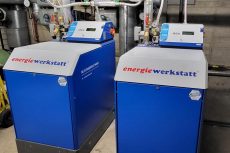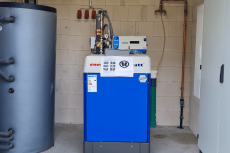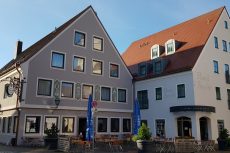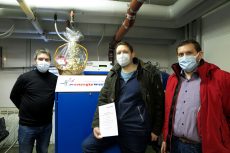Operating principle of cogeneration
Compared to conventional heating systems (CHP) generates not only heat but also electricity in a cogeneration plant.
In this decades-proven technology, an engine is coupled to a generator (cogeneration). The waste heat from the engine is used for heating purposes. The electricity generated is used for users own needs or is fed/sold into the public grid.
In conventional large power plants on average one-third of the fuel energy is converted into electricity only due to the heat not being used and thus released into the environment. Decentralized compact – Energiewerkstatts cogeneration plants have an overall efficiency of over 90% and by doing so make a substantial contribution to climate protection. Distribution losses through an extensive district heating system and the associated investment costs are avoided.
Operation Mode
Economy
Economy
In addition to the environmental benefits of operating highly efficient cogeneration plants ASV’s economical side is one of the most exciting in the whole market environment of distributed generation. In a matching system environment, i.e. at constant annual heat consumption and a high degree of internal current consumption, unrivaled economic calculations and short payback periods can be achieved.
Income and Earnings
The produced and self-used power can return regular revenues. It is important that the CHP comes to high running times of the year. The feed into the public grid surplus electricity is paid for by regional energy supply companies (utilities) and distribution system operators (DSOs). Since the majority of the electricity generated by the CHP plant is consumed in the object itself, the operator can be credited to the money thereby saving electricity costs.
Energy grants by the state
Furthermore, the operators will benefit from the CHP bonus, the current amount is 5.41 Cents (€) for 100 % of the electricity generated. A fuel credit is also available. In addition, there are regional CHP funding programs, as well as the mini-CHP support program in which grants of up to 4,375, – € are possible.
Besides reducing tax breaks even further over the payback period. On average, optimal planned cogeneration projects payback periods can be achieved over 3 – 5 years, calculated on the CHP investment costs. In an imputed useful life of 10 years, there are thus significant gain opportunities.
Below, you can perform a quick check on your energy demands and if the ASV-CHP can operate ecologically and economically.
Areas of application
ASV-Cogeneration plants be used wherever there is a need to simultaneously generate heat and electricity.
Good economy arises particularly when throughout the year consistently high heat usage is guaranteed, for example hot water usage.
Suggested use is therefore in larger residential complexes (from 20 units), hotels, schools, swimming pools, sports centers, senior residential homes etc.
A glance at the reference list shows how diverse the locations for our cogeneration plants are:
Integration
Some preparations must be made and to meet certain requirements for the use of CHP. The CHP will be integrated into the heating water circuit. A properly dimensioned electricity and gas connection should be available. In new buildings, it would make sense to calculate the necessary space required by the CHP from the very beginning. Integration: hydraulic integration – electrical integration – spacial integration.
Hydraulic integration
The cogeneration plant can be incorporated into several variants in an existing new heating system. In combination with a conventional heating (oil or gas burner), the CHP will be installed. Here, the CHP is coupled to the return line, as shown in the hydraulic diagram. Thus, no additional control of the heating system is required, since only the return temperature of heating water is lifted from the CHP. In this way, the CHP is responsible for the base load and the conventional boiler for peak load boiler.
Easy Integration
Easy integration form for the CHP (PDF)
Version A: The CHP in series with the boiler, which is always through flowing. Without buffer.
Hydraulic scheme
Version B: As version A. With buffer.
Hydraulic diagram 2
Version C: The CHP in series with a boiler. A switching valve determines the flow rate through the boiler.
Hydraulic scheme 3
Version D: The CHP in parallel with a boiler with buffer. We encourage this version of installation!
Hydraulic diagram with explanations (PDF)
Electrical integration
The CHP is connected via cut-outs at the main bus terminal or the main busbar. Multi-module systems often recommend a sub-distribution panel in CHP-room, but the modules can also be placed individually on the main busbar.
The cable cross-section and backup size is based on the number and type of cogeneration module:
A module ASV 21, 20, 15 and 14 requires a cross-section of at least 16 mm² and a hedge 3 * 50 A type NH 00th
A module ASV 30 and 40 requires a cross-section of 25 mm² and a hedge 3 * 80 A type NH 00th
This information as PDF for download:
Spacial integration
The space requirement of a cogeneration plant is an important consideration in planning.
The cogeneration module ASV 21, 20, 15 and 14, as well as the CHP ASV 30 and 40 has a footprint of 0.8 m x 1.20 m. The module should be set up with available access around the module for installation and maintenance.
We are happy to consult with you.
Up to 40 kW electrical cogeneration unit requires only one square meter of floor space. This base corresponds to a Euro pallet.
Position of ports
Thus, the CHP is immediately functional, additional ports are needed. The position of the connections are clearly shown in the PDF document.

